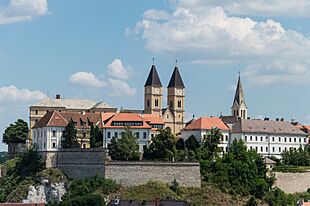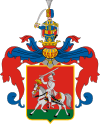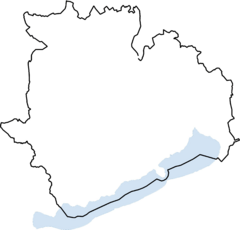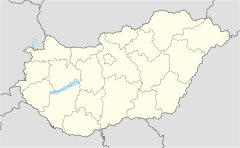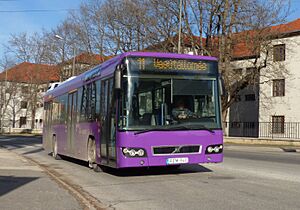Veszprém facts for kids
Quick facts for kids
Veszprém
|
|||
|---|---|---|---|
|
City with county rights
|
|||
|
From top, left to right: Castle Hill, County Library, Statue of King Stephen I and Queen Gisela, Fire-watch Tower, Veszprém Cathedral and Castle Gate
|
|||
|
|||
| Nickname(s):
City of Queens
|
|||
| Country | |||
| Region | Central Transdanubia | ||
| County | Veszprém | ||
| District | Veszprém | ||
| Established | 9th century AD | ||
| City status | 1870 | ||
| Named for | Bezprym of Poland | ||
| Area | |||
| • City with county rights | 126.93 km2 (49.01 sq mi) | ||
| Elevation | 266 m (873 ft) | ||
| Population
(January 1, 2017)
|
|||
| • City with county rights | 56,927 | ||
| • Rank | 16th | ||
| • Density | 448.49/km2 (1,161.6/sq mi) | ||
| • Urban | 133,880 (13th) | ||
| Demonym(s) | veszprémi | ||
| Population by ethnicity | |||
| • Hungarians | 83.9% | ||
| • Germans | 2.4% | ||
| • Gypsies | 0.7% | ||
| • Romanians | 0.1% | ||
| • Serbs | 0.1% | ||
| • Slovaks | 0.1% | ||
| • Armenians | 0.1% | ||
| • Bulgarians | 0.1% | ||
| • Polish | 0.1% | ||
| • Ukrainians | 0.1% | ||
| Population by religion | |||
| • Roman Catholic | 38.9% | ||
| • Greek Catholic | 0.3% | ||
| • Calvinists | 7.0% | ||
| • Lutherans | 2.1% | ||
| • Other | 1.4% | ||
| • Non-religious | 20.6% | ||
| • Unknown | 29.6% | ||
| Time zone | UTC+1 (CET) | ||
| • Summer (DST) | UTC+2 (CEST) | ||
| Postal code |
8200
|
||
| Area code | (+36) 88 | ||
| Airport | Veszprém | ||
| MP | Péter Ovádi (Fidesz) | ||
Veszprém (Hungarian pronunciation: [ˈvɛspreːm]; German: Weißbrünn, Czech: Bezpřím, Slovak: Bezprím, Slovene: Belomost) is one of the oldest urban areas in Hungary, and a city with county rights. It lies approximately 15 km (9 mi) north of the Lake Balaton. It is the administrative center of the county of the same name.
Contents
Etymology
The city's name derives from the West Slavic-language personal name Bezprem or Bezprym (Proto-Slavic Bezprěmъ) which translates literally to "stubborn", "self-confident, not willing to retreat". Besprem (before 1002), Vezprem (1086), Bezpremensis (1109). The form Vezprem originates in early medieval scribal habits and frequent exchange of B and V under the influence of the Greek language.
Location and legend
The city can be reached via the M7 highway and Road 8. It can also be reached from Győr via Road 82 and from Székesfehérvár via Road 8. According to a local legend, Veszprém was founded on seven hills. The seven hills are Várhegy (Castle Hill), Benedek-hegy (St. Benedict Hill), Jeruzsálem-hegy (Jerusalem Hill), Temetőhegy (Cemetery Hill), Gulyadomb (Herd Hill), Kálvária-domb (Calvary Hill), and Cserhát.
History
Anonymus Belæ Regis Notarius (the anonymous notary of King Béla III) wrote that a castle already stood here when the Hungarians first occupied the area. The castle was probably a 9th-century Frankish fortress. The castles of Veszprém, Esztergom and Székesfehérvár, were the earliest Hungarian stone castles, which had already been built during the reign of High Prince Géza, a time when motte castles were much more common.
Veszprém had an important religious role during the struggle to make Christianity the official religion of the medieval Kingdom of Hungary—Stephen I, Grand Prince of the Hungarians, was crowned King in 1000 or 1001, and defeated the armies of his chief opponent, Koppány, near Veszprém. The city became the first episcopal seat of Hungary in 1009 and an archiepiscopal seat in 1993. Comitatus Veszprém was one of the earliest historical counties of Hungary.
Veszprém was the favorite city of Queen Gisela, the wife of Stephen I. For centuries, the queens of Hungary were crowned by the bishop of Veszprém. The city is still often called "the city of queens". In the year 1294 Queen Fenenna confirmed that, at that time, the former Queen Elizabeth had the privilege to collect the donations of the church in the Veszprém County.
Veszprém was among the first Hungarian cities to have a university—students studied law and arts here for several centuries. The university was destroyed by fire in 1276, when Peter I Csák invaded and devastated the Diocese of Veszprém. Veszprém became a university town again in the 20th century.
The town was plundered by the Ottoman Turks during the Hungarian–Ottoman Wars in 1552, but they could not maintain occupation: the region north of Lake Balaton remained in the modern Kingdom of Hungary (captaincy between Balaton and Drava). The castle was demolished in 1706. Until 1918, VESZPRIM (also named WESZPRIM and WESPRIM near 1850, and WEISSBRUNN in German) was part of the Austrian monarchy/Austria-Hungary, Kingdom of Hungary; in Transleithania after the compromise of 1867 in the Kingdom of Hungary. Between 16 August and 4 October 1919, Romanian troops occupied the city under colonel Constantin Neagu and major Alexander Totescu.
During World War II, Veszprém was captured by Soviet troops of the 3rd Ukrainian Front on 23 March 1945, in the course of the Vienna Offensive.
Economy
The Hungarian automotive plastic spare parts manufacturer Videoton Plastic (part of Videoton), the Hungarian kiosk manufacturer Kiosksystems, the Hungarian shutter manufacturer Roll-Lux, the Hungarian label manufacturer Imprenta, the Hungarian tool manufacturer Solidsteel, the Hungarian technical ceramics manufacturer Bakony Ipari Kerámia, the Hungarian furniture manufacturer Balaton Bútor, the Hungarian machine manufacturer Flexmont, the Hungarian watermanagement company PureAqua, the Hungarian automotive spare parts manufacturer Win-Pres, the Hungarian construction company VEMÉVSZER, the Hungarian metal manufacturer Ferro-Trio, the Hungarian OOK Printhouse, the Hungarian toolmanufacturer Plasticor, the Hungarian machine manufacturer Transmoduls, the Hungarian Prospektus Printhouse have both their headquarters and main production facilities in Veszprém.
The French pharmaceutical company Citoxlab, the Austrian plaster manufacturer Lasselsberger-Knauf, the Swiss electric motor manufacturer Maxon Motor, the Austrian tile manufacturer Bramac, the French automotive spare parts manufacturer Valeo, the German electromagnetical controlsystems manufacturer nass magnet, the German automotive spare parts manufacturer Continental AG, the German automotive spare parts manufacturer Thun, the German sensor manufacturer Pepperl+Fuchs, the Austrian chimney and ventilation system manufacturer Schiedel, the American power supply security company CoreComm, the German sensor manufacturer Balluff, the German automotive spare parts manufacturer Jost, the German health devices manufacturer Beurer, the British-Dutch food producer Unilever and the Hungarian dairy product manufacturer Pannontej operate production plants in the city.
The Dutch General Logistics Systems, the Hungarian Magyar Posta, the German Penny Market, the Hungarian Locargo and the Austrian Persped have logistics centres there.
The Hungarian owned Vöröskő electrical retailer (holder of the brand Euronics in Hungary) is also based in the city.
The Veszprém Aréna provides place besides sport events for exhibitions and conferences.
Demographics
According to the 2011 census beside the 83.9% Hungarian majority the city has a historical German minority numbering 2.4% of the population. The second largest ethnic group is the Roma with 0.7%. The others are all marginal.
The religious affiliation of the citizens has a Catholic majority with 38.9% Roman Catholic and 0.3% Greek Catholic. The Calvinists (7.0%) have the second, the Lutherans (2.1%) the third largest denomination in the city. 20.6% are not religious.
Public transport
The city's public transportation consists exclusively of buses, which are run by the city-funded company V-Busz. 30 bus lines run throughout the city, including lines 44 and 45 which are night buses. All buses are easily recognizable even from a distance due to their purple livery. Tickets can be purchased on the buses, from ticket machines across the city and at bus stations from the ticket desks. V-Busz took over the city's public transportation in 2018 from the regional, state-funded bus company (ÉNYKK) due to a lack of funding and an old rolling stock of buses, some of which were from the mid 80s.
Notable people
| Historical population | ||
|---|---|---|
| Year | Pop. | ±% |
| 1870 | 14,279 | — |
| 1880 | 14,726 | +3.1% |
| 1890 | 14,807 | +0.6% |
| 1900 | 16,223 | +9.6% |
| 1910 | 16,864 | +4.0% |
| 1920 | 17,513 | +3.8% |
| 1930 | 19,991 | +14.1% |
| 1941 | 24,025 | +20.2% |
| 1949 | 20,682 | −13.9% |
| 1960 | 28,222 | +36.5% |
| 1970 | 40,415 | +43.2% |
| 1980 | 57,249 | +41.7% |
| 1990 | 63,867 | +11.6% |
| 2001 | 62,851 | −1.6% |
| 2011 | 61,721 | −1.8% |
| 2022 | 56,262 | −8.8% |
- Péter Andorka (born in 1984), footballer
- Leopold Auer (1845–1930), violinist, academic, conductor and composer
- Marian Cozma (1982–2009), handball player
- Tamás Kádár (born 1990), footballer
- Attila Mesterházy (born 1974), politician (MSZP)
- Tibor Navracsics (born 1966), politician, European Commissioner for Education, Culture, Multilingualism and Youth (2014–present)
- Leopold Óváry (1833–1919), historian and archivist
- Csaba Vastag (born 1982), singer
- Tamás Vastag (born 1991), singer
- Ádám Lang (born 1993), footballer
Twin towns – sister cities
Veszprém is twinned with:
Tourism
- Kittenberger Kálmán Zoo & Botanical Garden
Gallery
-
Statue of King Stephen I and Queen Gisela
See also
 In Spanish: Veszprém para niños
In Spanish: Veszprém para niños


